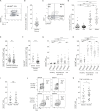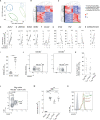HELIOS-expressing human CD8 T cells exhibit limited effector functions
- PMID: 38187391
- PMCID: PMC10770868
- DOI: 10.3389/fimmu.2023.1308539
HELIOS-expressing human CD8 T cells exhibit limited effector functions
Abstract
Introduction: The transcription factor HELIOS is primarily known for its expression in CD4 regulatory T cells, both in humans and mice. In mice, HELIOS is found in exhausted CD8 T cells. However, information on human HELIOS+ CD8 T cells is limited and conflicting.
Methods: In this study, we characterized by flow cytometry and transcriptomic analyses human HELIOS+ CD8 T cells.
Results: These T cells primarily consist of memory cells and constitute approximately 21% of blood CD8 T cells. In comparison with memory HELIOS- T-BEThigh CD8 T cells that displayed robust effector functions, the memory HELIOS+ T-BEThigh CD8 T cells produce lower amounts of IFN-γ and TNF-α and have a lower cytotoxic potential. We wondered if these cells participate in the immune response against viral antigens, but did not find HELIOS+ cells among CD8 T cells recognizing CMV peptides presented by HLA-A2 and HLA-B7. However, we found HELIOS+ CD8 T cells that recognize a CMV peptide presented by MHC class Ib molecule HLA-E. Additionally, a portion of HELIOS+ CD8 T cells is characterized by the expression of CD161, often used as a surface marker for identifying TC17 cells. These CD8 T cells express TH17/TC17-related genes encoding RORgt, RORa, PLZF, and CCL20.
Discussion: Our findings emphasize that HELIOS is expressed across various CD8 T cell populations, highlighting its significance beyond its role as a transcription factor for Treg or exhausted murine CD8 T cells. The significance of the connection between HELIOS and HLA-E restriction is yet to be understood.
Keywords: CD8 T lymphocytes; HELIOS; HLA-E; Tc17; human.
Copyright © 2023 Neyens, Hirsch, Abdel Aziz Issa Abdel Hadi, Dauguet, Vanhaver, Bayard, Wildmann, Luyckx, Squifflet, D’Hondt, Duhamel, Huaux, Montiel, Dechamps and van der Bruggen.
Conflict of interest statement
The authors declare that the research was conducted in the absence of any commercial or financial relationships that could be construed as a potential conflict of interest. The author(s) declared that they were an editorial board member of Frontiers, at the time of submission. This had no impact on the peer review process and the final decision.
Figures






References
Publication types
MeSH terms
Substances
LinkOut - more resources
Full Text Sources
Medical
Molecular Biology Databases
Research Materials

